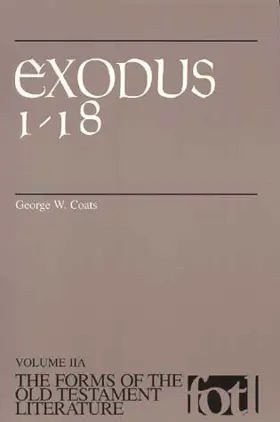

Exodus 1–18
in Forms of the Old Testament Literature
Pages
178 pages
Publisher
Eerdmans
Published
2/1/1999
ISBN-13
9780802805928
Exodus 1–18 is Volume IIA of The Forms of the Old Testament Literature, a series that aims to present a form-critical analysis of every book and each unit in the Hebrew Bible. Fundamentally exegetical, the FOTL volumes examine the structure, genre, setting, and intention of the biblical literature in question. They also study the history behind the form-critical discussion of the material, attempt to bring consistency to the terminology for the genres and formulas of the biblical literature, and expose the exegetical process so as to enable students and pastors to engage in their own analysis and interpretation of the Old Testament texts.
More than twenty-five years in preparation, this present study provides a form-critical analysis of the first eighteen chapters of the book of Exodus. Dividing his discussion between the Exodus and Moses traditions and the wilderness traditions, Coats examines each unit of the text of Exodus in turn, showing how the units’ internal structures reveal the genre and social setting in which the book was written and what that setting and genre mean for proper interpretation. Illuminating to scholars and students alike, this volume will open up a new perspective on this important section of Scripture.
Reviews
Grand Rapids: Eerdmans, 1999. Pp. xiv + 178, Paperback, $24.00, ISBN 0802805922. Thomas B. Dozeman United Theological Seminar Dayton, OH 45406 George Coats' commentary on Exodus 1-18 is a welcome addition to the FOTL series. The focus of FOTL on structure to interpret genre and the intentionality of a text accentuates the strengths of Coats' work. Through a series of important articles in the 1970s, Coats developed a method for discerning large structures in the Pentateuch by detecting tensions in the literature and by locating their point of resolution (e.g., "A Structural Transition in Exodus," VT 22 [1972] 129-42; "An Exposition for the Wilderness Tradition," VT 22 [1972] 288-95; and "Conquest Traditions in the Wilderness Theme," JBL 95 [1976] 177-90). This commentary brings together Coats' research on the book of Exodus. Coats interprets Exodus 1-18 within the framework of three large structures, an Exodus Saga, a Wilderness Saga, and a Moses Saga. The Exodus Saga includes Exod 1:1-13:17. Its central motif is the Egyptian oppression of the Israelites through hard labor. The tension surrounding this motif is resolved in the celebration of the Passover. The Exodus Saga is composed of J and P narratives. J is characterized form critically as Saga. It exhibits a national focus. The setting of the literature appears to be the family and is intended to create identity. P is also a Saga with a clearer cultic setting than J. It uses the exodus and Passover as catachesis. A Wilderness Saga extends from Exod 13:17 through Deut 34:12. The central theme of the Wilderness Saga is the leading of God. The theme of guidance provides transition between the exodus and the conquest themes, reaching resolution only when Israel enters the land of Canaan in the book of Joshua.
[Full Review]
